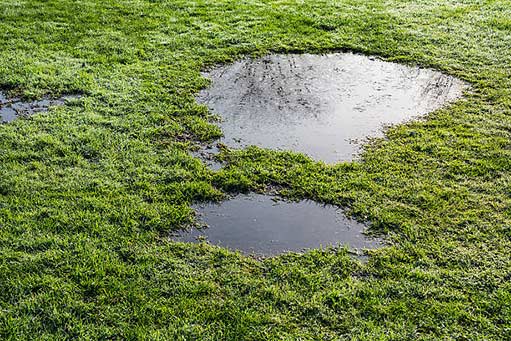
A home is said to have drainage issues when rainwater is not being efficiently removed from the property. Drainage issues are a major problem in many homes, according to Dennis Property Management, and they happen for various reasons: artificial and natural.
Common signs that a home has poor drainage include:
- Puddles or waterlogged areas in the yard
- Frequent incidents of basement flooding
- Dead/dying plants in the yard due to suffocation
- Mosquitoes breeding in areas of the yard
- Chronic soil erosion
- Structural damage to the building
What are the root causes of drainage issues in homes?
Common causes of poor drainage in Naperville homes
Improper grading
Ideally, your home should occupy the highest ground on your property, with the surrounding areas sloping gently away. That allows water to flow away from the building towards the street. If the ground around your home lacks the proper slope, it can result in poor drainage.
Poor landscaping design
When creating planting beds and other features in the landscaping, it is essential to grade them in the right way. Beds that slope toward the house or have too much topsoil or mulch can cause drainage problems on the property.
Malfunctioning downspouts and gutters
Roof gutters protect your home by channeling rainwater away from it. Downspouts collect water from gutters to discharge it at a safe place in the yard. If gutters and downspouts are damaged or badly installed, your home will have drainage issues.
The structure and nature of the soil
If the soil around or underneath a building is not properly compacted it can change in ways that will lead to drainage issues on the property. Soils with a high proportion of sand or clay are also prone to drainage problems.
A high water table
The level of the water table plays a role in an area’s vulnerability to drainage issues. Soil saturation happens faster in places with a high water table. If the existing drainage outlets on the property are inadequate, the soil can become waterlogged.
No or inadequate outlets for excess water
Ponding of stormwater will happen in your yard if the storm sewer inlets are clogged or nonexistent. Dead leaves, grass clippings, and other debris can build up around sewer inlets. This problem is usually not evident until there is a storm.
Tree root intrusion in drainage pipes
Tree roots can make their way into drainage pipes by squeezing through pipe joints. Once inside the pipes, these tree roots can grow until they block the pipe channel. Cracked, leaky and aged pipes are vulnerable to tree root intrusion.
Runoff from neighbors yard
The drainage issues in your property may originate from a neighbor’s property. That happens when a home is downhill from other homes. It is a tricky situation because there is not much your neighbor can do to prevent the problem.
Steps to solve the drainage issues in your Naperville home
Note that you need an expert to help you with these steps; attempting to tackle your home’s drainage issues by yourself is never a good idea. You could make the problems worse.
Inspect the yard for signs of poor drainage
Do a walkthrough of the property and pay extra attention to areas with clear signs of poor drainage. Things to look for include clogged or poorly installed gutters & downspouts, low-lying areas in the yard, signs of tree root intrusion in your sewer lines that needs removal.
Identify existing drainage systems
Is any of the city’s stormwater control systems – storm sewers, overflow routes and basins – located on your property? How does your drainage function with your neighbors drainage; do adjacent properties drain toward your yard?
Analyze your soil
How high is the water table in your area? Is the sand or clay composition of your soil very high? Is there evidence of soil erosion on your property? Is your home settling, or is there evidence of soil shifting that may be contributing to the issues?
Ensure that the yard is properly graded
Measures that promote the correct water flow across the yard – slopes, inclines and leveling depressed areas – help to minimize drainage problems. If topsoil erosion is part of the problem, replace eroded topsoil. Also, replace damaged sod with healthy soil.
Choose a drainage system for the yard
The best drainage system for your yard depends on the root causes of your problems. Some common options include installing French drains, berms, channel drains, catch basins, dry creek beds, downspout extensions, dry wells, and many more.
Finally, you want to ensure that after all the work you have put into understanding the problem and diagnosing the root causes of your drainage issues, your chosen yard drainage system will be effective in combating the drainage issues in your Naperville home.
The only way to ensure this is by working with established and licensed Naperville plumbers who understand the peculiar drainage challenges in this part of the state of Illinois.
—
Having drainage issues in the Naperville, IL area and need assistance? We can help! Contact us today at 708-801-6530 or by form below:
[gravityform id=”1″]

